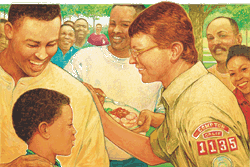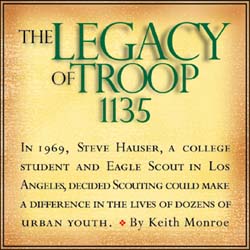 "That turned my life around."
"That turned my life around."
The Scouts in Troop 1135 were rebellious black teen-agers from South Central Los Angeles. Their Scoutmaster was an idealistic college student named Steve Hauser.
Maybe the ugliest moment in the troop's 10 years was when a Scout pulled a gun on the young Scoutmaster. Or maybe when one threatened him with a knife. There were times when Scouts threw rocks at him. Once his whole troop seemed ready to attack, chanting: "Get Whitey! Get Whitey!"
Steve Hauser quietly surmounted these deadly showdowns. They are forgotten now. When his ex-Scouts visit, they talk of achievements or chuckle at gleeful memories.
They finally arranged a troop reunion in September 1996. After 17 years, long-gone Los Angeles Troop 1135 met for a family barbecue in a shady Long Beach public park, a million miles from where they used to meet. They were a notable sight: 42 African-American young men, flocking around one slender white man in an old Scoutmaster's uniform, hugging him and clasping his hand and grinning.
After the meal came reminiscences. "I'd probably be in prison if it weren't for Steve," said 39-year-old Renard Stevenson, a Compton minister. "I joined the troop just to find things to steal at the Job Corps building where we met. In summer camp at Lake Arrowhead I stole food from other camps and hid it in my tent. Steve caught me, but he didn't get mad. He said: 'I guess you need more food. I'll start giving you more to eat.'
 "That turned my life around."
"That turned my life around."
Tommy Tucker, a 41-year-old television producer, said: "Remember why we wore big jackets to troop meetings, even in summer? To hide our uniforms, so other kids wouldn't pick on us."
"But we looked suspicious to cops," someone added. "Many a time they frisked us. Steve himself got pulled over sometimes."
"Any white man in that area might be buying or selling drugs," Hauser pointed out. "My Scout uniform didn't seem to make a difference."
Praising Steve Hauser as a role mod-el, 35-year-old tax accountant Barry Toston remarked, "I always wondered why you started the troop."
It had been a happenstance. The story, too long to tell at the barbecue, is worth recounting here.
In 1969 as a UCLA sophomore, Hauser joined a fraternity which nicknamed him "Holy Hauser" because he wasn't eager for drinking and partying.
The fraternity brothers put him in charge of public relations. "Get us good publicity," they ordered.
After pondering, Hauser proposed a party for inner-city youths: "We can drive them here, show them around, serve punch and cookies." This was done and duly reported on TV. The guests enjoyed it hugely, so a second party ensued.
In making arrangements, Hauser was dismayed by his glimpses of teeming South Central Los Angeles, where wholesome recreation was rare. That summer, on his own, he took a group of boys to the beach. As they rode home, one asked, "Steve, will we ever see you again?"
"Sure," he said on impulse.
He recalled later: "I realized they needed a regular activity they could look forward to. I could provide it. I could form a Scout troop."
An Eagle Scout, Hauser had served as senior patrol leader of Troop 6 in the comfortable, nearby town of Redlands.
A district executive helped Hauser start Troop 1135 that same summer. The core was 11 boys in a four-block area where stores had been destroyed during the historic 1965 riot.
Hauser promised a hike or camp-out every month and made good with the help of Allen Lundy, a fraternity brother. The new Scouts proudly donned thirdhand uniforms bought at discount stores for a dollar or two. The troop grew fast.
Hauser wasn't sure his Scouts really accepted him. But the question was settled one Saturday. Lacking enough transport for all 20 Scouts who'd signed up for camp, Hauser decided they would hike to a wooded area three miles away called Dominguez Hills.
As they filed along a city street, a man shouted, "How come you kids out here with a white man?"
Timothy Hamilton barked, "That's our business." The others chorused, "Yeah!"
There was no further public criticism. However, a few Scouts occasionally disrupted troop meetings, chattering or cavorting. Hauser usually asked them to leave. Any who didn't seem sufficiently repentant were barred from the next outing.
This so enraged one Scout that he lay in wait after the meeting and threw rocks at Steve's car. "I went to his house and told his mother," Hauser recalls. "She disciplined her son. The mothers were stricter than I was. Once the Scouts knew I'd tell, my threats had teeth."
The teeth of his threats seemed less biting on trips, however. On one weekend outing, a Scout shook a rock at Steve, who said calmly, "I know you won't throw it." But the youth did throw it, hitting Hauser squarely on the chest. The young Scoutmaster thereupon drove the Scout home, a two-hour trip, and returned to find the troop subdued.
As years passed, the summer trips became more ambitious, financed by Scoutorama ticket sales and other money-earning campaigns. The troop traveled in a 1953 school bus donated by a welfare agency.
In this vehicle Hauser took 20 Scouts to a redwood park in northern California. There they grew bold. Against orders to stay in camp, they strolled to a store while he showered. He found them in the store and commanded them to hike back to camp. Instead they took seats in the bus outside.
Hauser can tell the story with a laugh now. "I grabbed the little kid that was the worst troublemaker and dragged him out. I was careful not to hurt him. He squealed and cursed me, but the others slowly swaggered off the bus. I drove it away in a hail of rocks.
"Later in camp I heard chants, 'Get Whitey,' and saw the troop advancing, with sticks and rocks. I wondered if I'd exported the Watts riot to the redwoods. Then an idea came. I climbed on the bus step and yelled, 'I'm telling every one of your mothers.' The Scouts froze.
"Finally one said: 'Aw, Steve, we was only funnin'. Please don't tell.' But the kid who was the troublemaker drew a pocketknife and made some threats. I then took the knife away. He screeched: 'You better not go to sleep tonight. I'm gonna get a butcher knife and pay you back.'
"All that night I tensed at the slightest sound, but nothing happened. The troop behaved for the rest of the trip." (At the 1996 reunion several of the "rioters" assured Hauser they had been bluffing.)
There was no more trouble, except once when Hauser had to intervene between two of his Scouts. "One of them got beat up for answering too many questions at school. Finally he was challenged to a fight with a bigger Scout, and he showed up with a gun. I'd heard about it, so I was there.
"He pointed the gun at me and said, 'What you gonna do?' I knew neither boy wanted to fight. I just said, 'Knock it off, you guys,' and everyone went home."
By 1979 Hauser was out of college, married, and practicing law. He had no time for troop meetings. He persuaded two fathers to take charge and wrangled a $1,000 charitable donation to pay for supplies and outings. But Troop 1135 wasn't the same. It disbanded in a few years.
Nevertheless 39 of its alumni remain in touch with Hauser. One went to the U.S. Naval Academy. One is a college professor; another is a famed rap artist known as Coolio. Others are teachers.
A few are in prison. The rest are saddened to think of this, but they believe the troop had done the best it could.
The reunion gift to Hauser was an enlarged color photo of a joyous-looking Troop 1135 in uniform in 1972. It is mounted on a handsome desk piece with the Scout emblem and an inscription that says in part: "Steve, your pure and innocent display of care and concern...has bound us all together for life."
Freelance writer Keith Monroe is a frequent contributor to Scouting magazine. He lives in Los Angeles.
| The Boy Scouts of America | http://www.scouting.org |